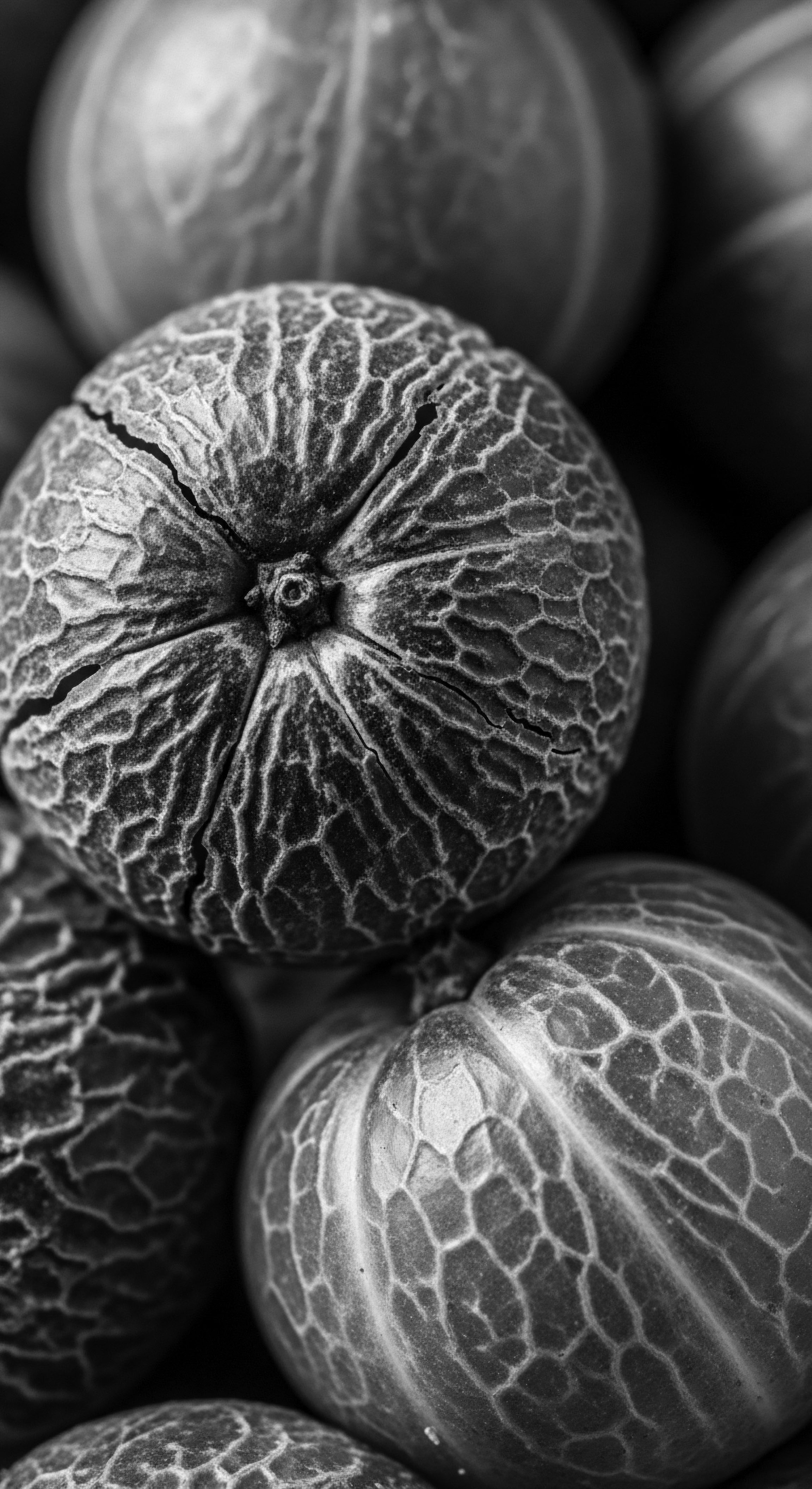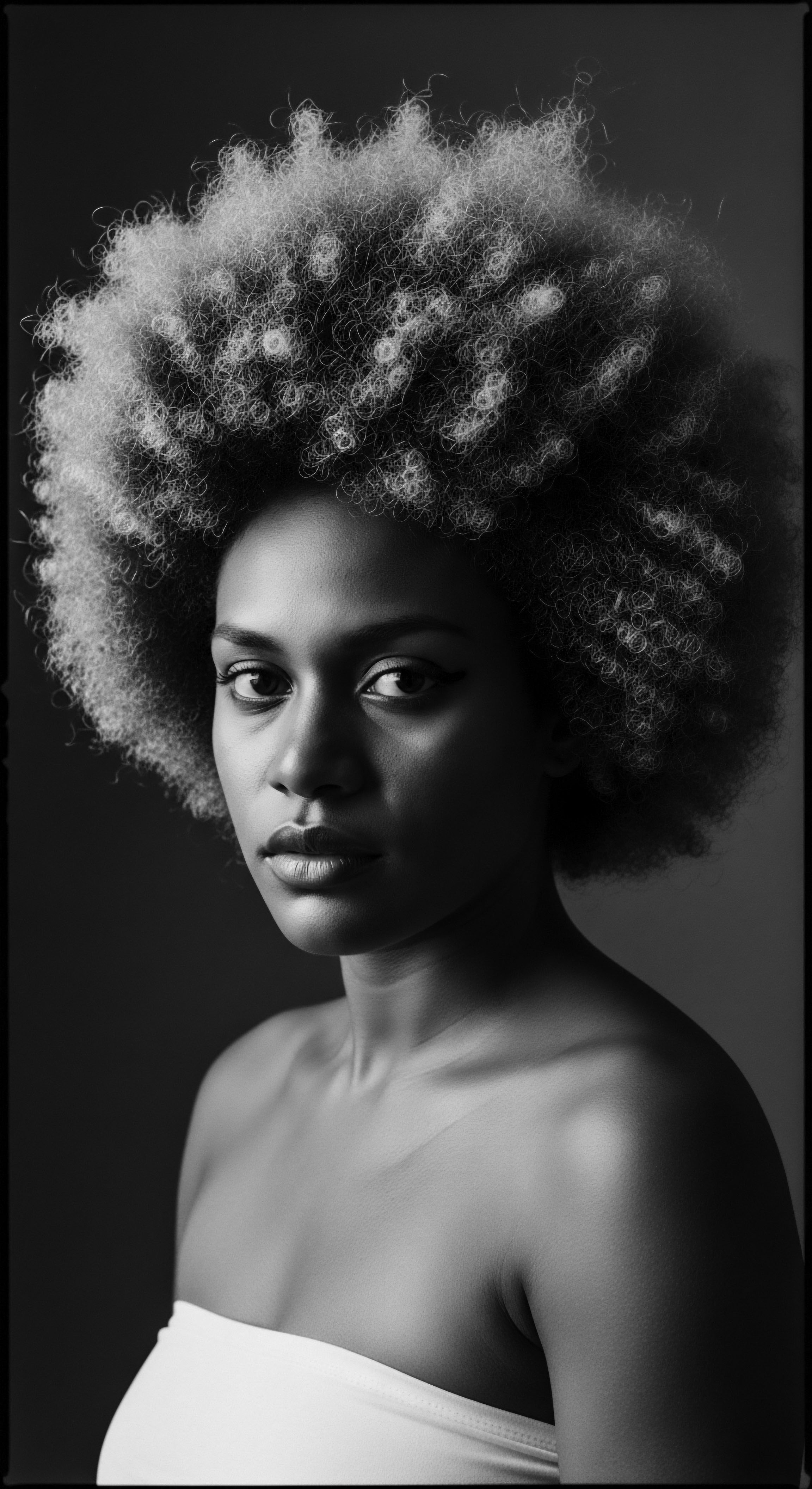
Roots
For generations, the texture that crowns our heads has been more than a mere biological attribute; it is a living chronicle, a deeply personal archive of identity, perseverance, and ancestral wisdom. Across the Black and mixed-race diaspora, hair has always spoken, carrying the whispers of those who came before us, adapting, surviving, and radiating beauty in its countless forms. The question of how to tend this particular canvas, how to imbue it with lasting moisture and vitality, is not a modern dilemma.
It echoes a timeless inquiry, one that stretches back to communal rituals under ancient skies and extends to the very molecules that compose each strand. We speak of fermented oils and their ability to improve moisture retention, yet to truly comprehend this contemporary inquiry, we must first kneel at the wellspring of our shared hair heritage, understanding the strand not as a simple fiber, but as a vessel of memory and biological marvel.
The intrinsic design of textured hair, with its unique elliptical cross-section and characteristic coiling patterns, presents a distinct set of hydration needs. Each bend and curve along the hair shaft acts as a potential point for moisture evaporation, making it inherently more prone to dryness than straighter hair types. This structural reality has shaped the hair care practices of our forebears, compelling them toward ingredients and methods that prioritized preservation and lubrication.
Ancestral insights, often gleaned through generations of observation and experimentation, recognized the vital connection between natural oils, environmental factors, and the hair’s capacity to retain its supple nature. The ingenuity of these practices often went beyond simple application, hinting at a subtle understanding of botanical properties that modern science is only beginning to fully articulate.

The Hair’s Intricate Architecture and Ancestral Understanding?
Delving into the microscopic world of textured hair, we observe the cuticle, that outermost layer of overlapping scales, designed to protect the inner cortex. In curly and coily patterns, these scales tend to be more lifted or less tightly sealed, allowing moisture to escape more readily and making the hair feel dry and vulnerable. Historically, communities understood this vulnerability through lived experience. They didn’t possess electron microscopes, yet their methods, often involving rich butters and thick oils, effectively mimicked the sealing action that modern conditioners aim to achieve.
Consider the application of shea butter in West African traditions, a staple for its protective and moisturizing properties, guarding hair against harsh climates and contributing to its health. This practical wisdom, handed down through families, formed the bedrock of care regimens.
The hair’s internal structure, the cortex, composed of keratin proteins, is where much of its strength and elasticity reside. Maintaining its integrity is paramount for moisture retention. When hair lacks water, these protein bonds can become rigid, making the hair brittle and susceptible to breakage. Our ancestors, through trial and error, discovered ingredients that seemed to nourish this inner core, even if they described the effects in spiritual rather than scientific terms.
The focus was always on robust hair, hair that could withstand styling, environmental exposure, and the rigors of daily life. This collective understanding laid the groundwork for what we now refer to as moisture retention, a continuous effort to keep the hair resilient and pliable.
Textured hair, a living archive of heritage, carries unique moisture retention needs embedded in its very coiled structure.

The Ancient Science of Sustaining Hair’s Suppleness
Beyond simple oils, ancestral practices often involved preparations that were, unknowingly, precursors to modern biotechnological processes. The application of certain plant saps, infused waters, or even particular muds suggests an intuitive grasp of how natural elements interact with hair fibers. While not “fermented oils” in the commercial sense we discuss today, these preparations often underwent natural transformations that altered their properties, making them more efficacious.
This speaks to a continuous thread of experimentation within hair care traditions, a legacy of seeking deeper benefits from nature’s bounty. The very concept of “improved bioavailability,” a key benefit of modern fermented oils, finds an echo in these historical practices, even if the language used to describe them was different.
The lexicon of textured hair care, both ancient and evolving, reflects a persistent quest for vitality. Terms like “hydration,” “sealing,” and “conditioning” have historical counterparts in expressions describing a hair’s plumpness, its ability to repel dryness, or its pliable feel. These words, whether in a diasporic dialect or scientific journal, all point to a singular aspiration ❉ to keep textured hair vibrant and enduring. The pursuit of moisture, then, is not a trend; it is a deeply embedded aspect of textured hair’s heritage, a testament to generations who understood the delicate balance required to keep their crowns thriving.

Ritual
The daily and weekly care of textured hair has always been a ritual, a communal act, a moment of connection not just to one’s own strands, but to a lineage of hands that have smoothed, braided, and adorned hair through the ages. Within this rich tapestry of care, the application of oils has held a central position, long before the advent of modern cosmetic science. Now, as we explore whether fermented oils can truly improve textured hair’s moisture retention, we step into a dialogue between ancestral wisdom and contemporary understanding, recognizing that some of the most potent answers lie in the subtle transformations of nature itself.
The ancestral practice of using various oils—palm oil, coconut oil, shea butter, even animal fats—was born from necessity and refined by experience. These were not casual applications; they were deliberate acts, integrated into styling routines to protect vulnerable hair, add a protective layer, and impart a coveted sheen. For example, in many parts of Africa, specific hair oiling rituals were part of elaborate protective styles that helped retain length and shield hair from environmental aggressors. This deep understanding of hair’s needs within diverse climates and lifestyles laid the foundation for modern moisture retention strategies.

How Did Ancient Practices Foresee Modern Fermentation’s Role?
It is here, in the exploration of historical practices, that we encounter compelling whispers of fermentation’s quiet presence. While not always explicitly named or understood in microbiological terms, certain traditional preparations hint at processes akin to fermentation. A notable example comes from communities in Ethiopia and Somalia, where women historically utilized a specific “hair butter” created from whipped animal milk and water to condition their hair, yielding remarkable results. This product, often referred to as kibe, was indeed made from naturally fermented milk and explicitly noted for its use in hair dressing (Gonfa et al.
2001, as cited in Degnet et al. 2017). This ancestral practice stands as a powerful testament to the long-standing, intuitive recognition that transformed or processed natural ingredients could possess unique benefits for hair, including enhanced suppleness and manageability.
Ancestral hair practices, like the Ethiopian use of fermented milk butter, presaged modern insights into enhanced ingredient efficacy.
The genius of such practices lies in their empirical validation over centuries. Communities observed that certain preparations yielded superior results ❉ hair that was softer, less prone to tangles, and seemingly more resilient against dryness. Modern science now offers an explanation for these observed benefits. Fermentation, a biological process involving microorganisms like bacteria and yeasts, breaks down complex molecules within oils into smaller, more bioavailable components.
This molecular transformation means that the nutrients—fatty acids, vitamins, antioxidants—become more accessible to the hair shaft and scalp, allowing for deeper penetration and more effective action. When we consider fermented oils today, we are, in a sense, validating and amplifying an ancient understanding of nature’s transformative power.

Styling Through Time ❉ A Moisture Continuum
The journey of textured hair styling is inextricably bound to the quest for moisture. From elaborate braids and twists, often infused with concoctions of oils and herbs, to the careful sectioning and application of butters before threading, every technique traditionally aimed to protect and hydrate. These methods weren’t just about aesthetics; they were about preserving the integrity of the hair fiber itself, minimizing friction, and sealing in moisture.
- Chebe Powder ❉ Used by Basara women of Chad, mixed with oils and fats, applied to hair, and then braided to retain moisture and promote length. This is an illustration of how traditional communities recognized the synergy between various natural components.
- Whipped Milk Butter (Kibe) ❉ As noted, utilized by Ethiopian and Somali women, this fermented dairy product served as a potent conditioner for hair dressing, demonstrating a sophisticated ancestral understanding of beneficial transformations.
- Plant Infusions ❉ Across various African regions, botanicals were steeped in oils or water, allowing for the extraction of compounds that would then be applied for hair and scalp health. Though not always “fermented” in the strictest sense, these infusions illustrate the practice of drawing out deeper benefits from natural ingredients.
The advent of modern hair science brings new tools and terms, but the core objective remains consistent with ancestral pursuits ❉ keeping textured hair moisturized and pliable. Fermented oils, by virtue of their molecular alterations, can enhance this process. They offer a refined approach to traditional oiling, potentially delivering active compounds with greater efficiency. This means that styling techniques, whether ancient or contemporary, can be bolstered by ingredients that work in greater harmony with the hair’s unique structure.
| Traditional Practice Application of Shea Butter |
| Community/Region West Africa |
| Reported Use Moisturizing, protecting hair from harsh environmental conditions. |
| Modern Scientific Resonance Occlusive properties for moisture sealing; rich in fatty acids and vitamins for external conditioning. |
| Traditional Practice Hair Butter from Fermented Milk (Kibe) |
| Community/Region Ethiopian, Somali communities |
| Reported Use Softening, shining, dressing hair; extended shelf life. |
| Modern Scientific Resonance Increased bioavailability of nutrients due to fermentation; potential for scalp microbiome balance. |
| Traditional Practice Chebe Powder with Oils |
| Community/Region Basara Tribe, Chad |
| Reported Use Length retention, moisture locking in protective styles. |
| Modern Scientific Resonance Physical barrier creation; herbal properties for scalp health and fiber strength. |
| Traditional Practice Coconut Oil and Palm Oil |
| Community/Region Various African cultures |
| Reported Use General moisturization, protection, and health maintenance. |
| Modern Scientific Resonance Penetrating fatty acids for internal hydration; lauric acid’s affinity for hair protein. |
| Traditional Practice These ancestral methods reveal a deep, practical understanding of moisture management, now illuminated by scientific principles. |

Relay
To understand the profound impact of fermented oils on textured hair’s moisture retention is to witness a grand relay, a passing of the torch from ancient wisdom to modern scientific revelation. The question of whether these transformed botanicals truly hold the key to deeper, more lasting hydration cannot be separated from the collective memory of textured hair care – a legacy built on the very principles of drawing strength and sustenance from the earth’s raw offerings, and often, from their quiet, biological transformations. It is a story where the cellular dance of microorganisms in a fermenting oil mirrors the enduring spirit of resilience in Black and mixed-race hair heritage.
Textured hair, with its unique coiling and porosity, requires a consistent, nuanced approach to moisture. Its structure, while beautiful and varied, renders it inherently more prone to water loss compared to straighter hair types. For generations, our communities have combated this challenge with ingenuity, creating regimens that might appear simple on the surface, but were, in fact, highly sophisticated in their application of available natural resources.
The ancestral commitment to practices like regular oiling and protective styling was a tacit acknowledgment of this need for perpetual hydration and protection. Fermented oils step onto this stage not as a wholly new concept, but as a scientifically enhanced continuation of this venerable lineage.

Do Fermented Oils Truly Offer Enhanced Hydration for Coiled Strands?
The heart of fermented oils’ promise lies in their altered molecular structure. The fermentation process, orchestrated by beneficial microorganisms such as bacteria or yeasts, breaks down larger oil molecules into smaller, more absorbable forms. Imagine a finely woven basket, representing the hair shaft, and water droplets trying to enter. Larger droplets might sit on the surface, evaporating quickly.
But smaller, more refined droplets can slip through the weave, reaching deeper into the core. This is analogous to how fermented oils work. Their enhanced bioavailability means that the active compounds—fatty acids, antioxidants, vitamins, and even newly synthesized postbiotics—can penetrate the hair cuticle more effectively and deliver nourishment directly to the cortex.
This deeper penetration is absolutely vital for textured hair. When the internal structure of the hair is adequately moisturized, the strand becomes more pliable, less brittle, and better able to resist breakage. Fermented oils create a protective yet breathable film on the hair’s surface, helping to seal in this newfound internal hydration, rather than merely sitting atop the strand. This duality—deep absorption and surface protection—is a significant advantage for maintaining moisture levels, particularly for hair types that struggle with water retention.
Fermentation reduces oil molecules, allowing deeper penetration and more effective moisture retention for textured hair.

A Deep Dive into the Science of Enhanced Bioavailability and Ancestral Echoes
The microorganisms involved in fermentation produce a range of beneficial byproducts, including organic acids, peptides, and even some vitamins. These compounds contribute to a healthier scalp microbiome, which is the foundational ecosystem for healthy hair growth. A balanced scalp environment, free from excessive dryness or oiliness, translates directly to improved hair quality.
Consider the traditional uses of various plant extracts and natural concoctions applied to the scalp for wellness, practices that instinctively understood the connection between a healthy root environment and vibrant hair. The fermentation of oils brings a scientific precision to this ancestral insight, offering prebiotics and postbiotics that support this delicate scalp balance.
For instance, studies on fermented rice water, a tradition deeply embedded in certain Asian cultures but whose scientific principles apply universally to fermentation, reveal a significant increase in inositol (Vitamin B8) and panthenol (Vitamin B5). These compounds are well-documented for their ability to strengthen hair, improve elasticity, and lock in moisture. The very act of transforming a simple grain into a hair-fortifying elixir through fermentation showcases how biological processes can unlock hidden potentials, echoing the subtle alchemy our ancestors performed with their natural ingredients.
- Increased Nutrient Delivery ❉ Fermentation breaks down complex structures, allowing beneficial fatty acids, vitamins, and antioxidants to reach the hair’s inner layers more efficiently.
- Scalp Microbiome Balance ❉ Probiotic and postbiotic compounds resulting from fermentation help foster a healthy scalp environment, reducing common issues like dryness and irritation that impede moisture retention.
- Improved PH Balance ❉ Some fermented ingredients can help to bring the hair and scalp to a more acidic pH (around 4.5-5.5), which helps to smooth the cuticle, reducing frizz and sealing in moisture.
When discussing moisture retention, we often speak of the “LOC” method (Liquid, Oil, Cream) or “LCO” method, regimens that rely on layering products to seal in hydration. Fermented oils fit seamlessly into this framework, acting as a more potent “O” layer. Their refined nature means they can provide substantial sealing and nourishment without the heavy, greasy feel that some traditional raw oils might impart, especially for those with finer textured strands. This allows for versatility in application, honoring the diverse needs within the textured hair community while building upon time-honored practices.
| Benefit Category Enhanced Penetration |
| How Fermentation Aids Moisture Retention Smaller molecular size allows active compounds to pass the cuticle more readily, reaching the hair cortex. |
| Connection to Textured Hair Heritage Supports ancestral desire for deep nourishment and lasting suppleness from traditional oils and butters. |
| Benefit Category Nutrient Enrichment |
| How Fermentation Aids Moisture Retention Increases levels of vitamins, amino acids, and antioxidants during the microbial process. |
| Connection to Textured Hair Heritage Validates the intuitive ancestral practice of seeking potent, life-giving properties from natural botanical concoctions. |
| Benefit Category Scalp Health |
| How Fermentation Aids Moisture Retention Introduces beneficial postbiotics, balancing the scalp's microbiome and reducing irritation. |
| Connection to Textured Hair Heritage Aligns with traditional holistic approaches to hair care, recognizing scalp vitality as key to overall hair wellness. |
| Benefit Category Film Formation |
| How Fermentation Aids Moisture Retention Creates a protective yet lighter barrier on the hair shaft, reducing moisture evaporation. |
| Connection to Textured Hair Heritage Offers a sophisticated refinement of ancestral sealing methods, improving manageability without heavy residue. |
| Benefit Category Fermented oils represent a powerful convergence, amplifying traditional hair care goals through contemporary scientific understanding. |

Can Fermented Oils Offer a Unique Solution for Textured Hair Concerns Beyond Hydration?
While moisture retention is a primary concern, the benefits of fermented oils extend further. The improved absorption and nutrient density can contribute to overall hair resilience, reducing instances of breakage and split ends. For textured hair, which is inherently more fragile due to its coiled structure and multiple fracture points, this reinforcement is invaluable.
Ancestral wisdom often sought ingredients that strengthened hair, seeing healthy hair as a symbol of vitality and prosperity. Fermented oils, by fortifying the hair from within and without, uphold this ancient aspiration.
Moreover, the balanced pH and antioxidant properties of many fermented oils offer protection against environmental stressors and styling damage. In historical contexts, hair was often exposed to harsh sun, wind, and dust, necessitating robust protective measures. Today, while the threats may differ—from heat styling to chemical treatments—the need for robust defense persists.
Fermented oils, therefore, serve as a bridge, connecting ancestral needs for protection with modern challenges, offering a technologically advanced yet deeply natural solution rooted in the very transformative processes revered by our forebears. They are a testament to the fact that the journey of hair care, particularly for textured hair, is one of continuous discovery, always drawing inspiration from the past while moving toward a future of holistic well-being.

Reflection
The conversation surrounding fermented oils and their capacity to improve textured hair’s moisture retention unfolds as a profound meditation on the enduring soul of a strand. This exploration has been more than a scientific inquiry; it has been a pilgrimage through the collective memory of hair, a journey that reveals the interwoven destinies of ancestry, wisdom, and biological marvel. We have walked through the historical landscapes where hands, guided by generations of observation, intuitively prepared ingredients that harnessed the earth’s subtle alchemy. We have witnessed how the very structure of textured hair, with its unique thirst for moisture, has shaped care practices across continents and centuries.
The efficacy of fermented oils, rooted in their enhanced bioavailability and nutrient density, stands not as a dismissal of ancestral methods but as a powerful validation. It is a modern echo of ancient ingenuity, a testament to the fact that the power of transformation has always been central to our hair heritage. The women who churned fermented milk into a conditioning butter for their hair in Ethiopia and Somalia were, in their own way, engaging with the very principles of biochemical enhancement that contemporary laboratories now isolate and measure (Gonfa et al.
2001). This continuity underscores a timeless truth ❉ the deepest innovations often spring from the wellspring of inherited knowledge.
Roothea’s ‘Soul of a Strand’ ethos is precisely this ❉ a living, breathing archive where the past informs the present, and the present honors the past. The quest for moisture retention in textured hair transcends mere cosmetic concern. It is a act of reclamation, an affirmation of self, and a homage to the resilience of those who, through immense hardship, preserved and passed down traditions of care. Each coil and wave carries a story, a legacy of adaptation and an unbreakable spirit.
As we consider fermented oils, we are not just asking about a product; we are asking about how we can continue to nourish this living heritage, ensuring that the wisdom of our ancestors, reinterpreted through contemporary understanding, continues to allow our strands to radiate their inherent beauty and strength. The journey of textured hair is, and always will be, a powerful reflection of an unbound helix, ever evolving, always connected to its profound roots.

References
- Degnet, M. Fekadu, G. & Wubie, A. (2017). Traditional Butter and Ghee Production, Processing and Handling in Ethiopia ❉ A Review. Asian Journal of Agricultural Extension, Economics & Sociology, 17(1), 1-13. (Cited for Gonfa et al. 2001)
- Kang, J. I. Yoon, H. S. Kim, S. M. Park, J. E. Hyun, Y. J. Ko, A. & Kang, H. K. (2018). Mackerel-Derived Fermented Fish Oil Promotes Hair Growth by Anagen-Stimulating Pathways. International Journal of Molecular Sciences, 19(9), 2735.
- Lee, C. H. & Kim, M. K. (2018). The effect of fermented fish oil on hair growth in mice and its mechanism of action. Journal of Cosmetic Science, 69(5), 329-338.
- Voeks, R. A. & Rashford, J. (Eds.). (2013). African Ethnobotany in the Americas. Springer.
- Carney, J. A. & Rosomoff, R. N. (2009). In the Shadow of Slavery ❉ Africa’s Botanical Legacy in the Atlantic World. University of California Press.
- Loussouarn, G. et al. (2005). Hair shaft shape and hair curling. International Journal of Dermatology, 44(s1), 2-6. (General reference for hair anatomy/fragility).
- Gonfa, A. et al. (2001). Traditional processing and utilization of milk and milk products in selected areas of Ethiopia. Ethiopian Journal of Animal Production, 1(1), 71-84. (Original source cited in Degnet et al. 2017 for kibe use).
- Oguntoyinbo, F. A. (2014). Fermented foods of Africa ❉ microbial diversity and its beneficial effects. In African traditional foods ❉ processing and health benefits (pp. 1-28). Springer.
- Okoro, N. J. (2019). Traditional African hair care practices and their scientific basis. Journal of Cosmetology & Trichology, 5(3), 1-5.
- Walker, A. (2001). On Her Own Ground ❉ The Life and Times of Madam C. J. Walker. Scribner. (General reference for African American hair history).
- Zulu, L. & Ngobeni, D. (2020). Ethnobotanical survey of plants used for cosmetic purposes in traditional African societies. Journal of Medicinal Plants Research, 14(7), 333-345.
